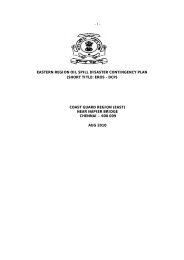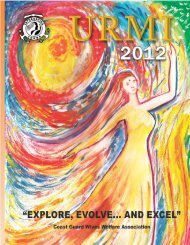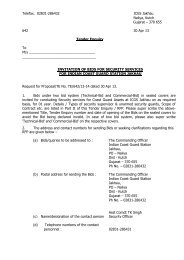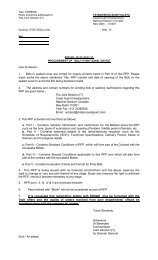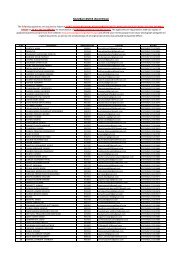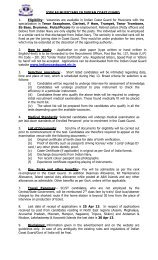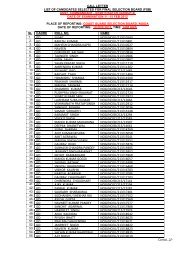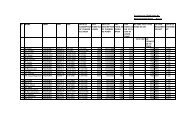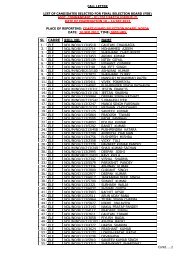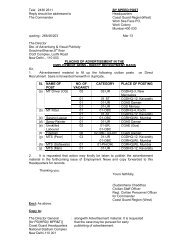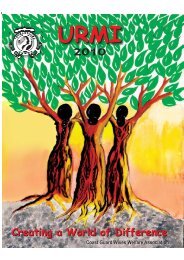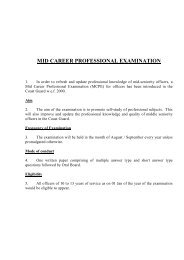Bio-remed Oil spills - Indian Coast Guard
Bio-remed Oil spills - Indian Coast Guard
Bio-remed Oil spills - Indian Coast Guard
Create successful ePaper yourself
Turn your PDF publications into a flip-book with our unique Google optimized e-Paper software.
<strong>Bio</strong>-<strong>remed</strong>iation <strong>Bio</strong> <strong>remed</strong>iation techniques for<br />
responding to <strong>Oil</strong> <strong>spills</strong> at Sea<br />
Dr Pradeep Kumar<br />
Naval Materials Research Laboratory (NMRL)<br />
DRDO, Min. of Defence, Defence,<br />
Ambernath 421506,<br />
Thane, Maharashtra
EFFECTS OF SPILLED OIL ON<br />
BIRDS<br />
ANIMALS<br />
TURTLES<br />
Short-term Short term effects<br />
Tarring of beaches,<br />
Damage to fisheries<br />
Water Contamination<br />
Long-term Long term effects<br />
Persistent toxic chemical in water & soil<br />
Permanent genetic mutation on entry through food<br />
chain<br />
<strong>Oil</strong> Pollution<br />
EELS
Methods<br />
a) Natural<br />
Evaporation, Dissolution<br />
Photo-oxidation<br />
Photo oxidation<br />
<strong>Bio</strong>degradation<br />
Sedimentation, Dispersion,<br />
Spreading and Drifting<br />
d) <strong>Bio</strong><strong>remed</strong>iation<br />
ODB, <strong>Bio</strong>emulsifier, <strong>Bio</strong>emulsifier,<br />
other<br />
mediators<br />
Possible methods of oil spill removal<br />
b) Physical<br />
Mechanical recovery (Skimmers,<br />
Booms, Suctions, Separation)<br />
c) Chemical<br />
Sorbents – inorganic/organic<br />
(Vermiculites,Glass wool,Carbon<br />
Wool, foam)<br />
Limitations<br />
Limited to low MW<br />
Fractions.<br />
Slow and controlled by<br />
environmental factors.<br />
Limited Efficiency.<br />
Environmentally controlled.<br />
Clumsy, time consuming<br />
and costly.<br />
Requires other physical<br />
methods<br />
Reuse of<br />
chemicals/sorbents<br />
chemicals/ sorbents<br />
impractical.<br />
Requires supply of<br />
nutrients<br />
Adaptability<br />
Restricted<br />
Restricted<br />
Restricted<br />
Restricted and<br />
Unacceptable.<br />
Restricted<br />
Not ecofriendly.<br />
ecofriendly<br />
Ecofriendly and<br />
easy application.
<strong>Bio</strong><strong>remed</strong>iation<br />
What is bio<strong>remed</strong>iation?<br />
Management of pollution through <strong>Bio</strong>logical means<br />
<strong>Bio</strong><strong>remed</strong>iation of pollutant oil<br />
– microorganisms (fungi or bacteria)<br />
– to decompose toxic pollutants<br />
– Enhanced biodegradation of petroleum hydrocarbons<br />
– <strong>Bio</strong>degradation<br />
a natural process by which microbes alter and break<br />
down petroleum hydrocarbons into other substances.<br />
– Resultant products: products:<br />
CO 2, , water, and partially oxidized biologically inert by-<br />
products (Bragg et al. 1992).
AD/ABSORPTION<br />
BIOREMEDIATION<br />
TECHNOLOGIES<br />
BIOREMEDIATION<br />
PLANT MATERIALS BIOSURFACTANTS BIOPOLYMERS<br />
STRAW, SAW DUST, WOODSHAVINGS<br />
LOW MW BIOCHEMICALS<br />
TO CLEAN OILED SURFACE<br />
BIOEMULSIFIERS & ENZYMES
<strong>Bio</strong><strong>remed</strong>iation: Advantages<br />
Minimal physical disruption of site.<br />
No adverse effect, when used correctly.<br />
Helpful in removing - toxic components<br />
of oil.<br />
Simple and more thorough approach<br />
than mechanical technologies.<br />
Relatively less costly.
<strong>Bio</strong><strong>remed</strong>iation: Limitations<br />
Effectiveness may vary for different<br />
types of <strong>Oil</strong> (<strong>Oil</strong> Crude, HSD, FFO)<br />
May not be convenient during heavy<br />
rains & low visibility.<br />
Quick & specifically tailored approach<br />
for each polluted site.<br />
May require 2-3 2 3 periodic spraying of<br />
Nutrient depending upon the density of<br />
spilled oil.
DRDO<br />
OIL SPILL CONTROL TECHNOLOGY
Schematic representation<br />
<strong>Bio</strong><strong>remed</strong>iation of oil in marine environments<br />
HSD+<br />
Bacteria+<br />
BE. HSD+<br />
Bacteria+<br />
BE+<br />
Nutrient<br />
HSD+<br />
Bacteria+<br />
BE+<br />
Nutrient+<br />
Oxygen
Infra-red Infra red<br />
signals<br />
(FTIR)<br />
Solubility<br />
Toxicity<br />
Characteristics : NMRL <strong>Bio</strong>emulsifier<br />
Thermal<br />
properties<br />
(TGA, under<br />
N2 ENV.)<br />
Molecular<br />
Weight (GPC)<br />
IDT 200°C. 200 C.<br />
STABLE UP<br />
199°C 199 C<br />
Peak Mw.5919;<br />
Polydispersity<br />
1.11.<br />
Alcohol, ester,<br />
carboxyl and<br />
proteins.<br />
Alcohol,<br />
Seawater and<br />
HSD<br />
Non toxic<br />
(Endotoxin Endotoxin free).<br />
80<br />
SURFACE TENSION<br />
(mN/m)<br />
70<br />
60<br />
50<br />
40<br />
30<br />
20<br />
SURFACE TENSION REDUCTION BY BE<br />
Sea water<br />
Syn. Sea water<br />
Distilled Water<br />
0 0.1 0.2 0.3 0.4 0.5 0.6 0.7<br />
BE CONC. (%)<br />
OIL Eating Bacteria<br />
Hallomonas cupida<br />
Pseudomonas stutzeri<br />
Bacillus pumilus<br />
Bacillus sphericus<br />
Micrococcus roseus<br />
Micrococcus varians. varians<br />
Characterized by Genetic<br />
engineering techniques and genes<br />
involved in biodegradation are<br />
sequenced.
Trials on <strong>Bio</strong><strong>remed</strong>iation of floating oil using<br />
<strong>Bio</strong>emulsifier<br />
• First <strong>Bio</strong><strong>remed</strong>iation Trial :<br />
• NMRL <strong>Bio</strong>emulsifier, <strong>Oil</strong> degrading bacteria and<br />
Nutrient compound as compared to control.<br />
• Naval harbour, Mumbai,(April 20th 2001),<br />
• Area of 25 m2 • Fast and effective dispersion (90 – 95% dispersion) and<br />
degradation of HSD (10 days) .<br />
• Extended Trials: 40 lit of weathered oil (Dec.21st to 31,<br />
2001): in an extended area of 100 m2 80-85% dispersion in 8-<br />
10days.<br />
• Conclusion: The results indicated effective dispersion of<br />
floating oil within 8-10 days.
MATERIALS REQUIRED FOR BIOREMEDIATION OF<br />
FLOATING OIL (30 gallons) IN AN AREA OF 500 m 2<br />
BIOEMULSIFIER<br />
NUTRIENT MIXTURE<br />
OIL DEGRADING<br />
BACTERIA (ODB)<br />
50 grams<br />
10 litres.<br />
40 litres<br />
(10g powder)<br />
TOTAL RECURRING COAST<br />
(BE+NUTRIENT+ODB)<br />
Approximately Rs.50,000 / tonne of oil<br />
Rs2500/-<br />
Rs2000/-<br />
Rs500/-<br />
Rs5000/
<strong>Bio</strong><strong>remed</strong>iation process -Flow chart<br />
Spray all the ingredients evenly and sequentially as given below<br />
Day ‘0’ 3 rd Day 6th Day 9th Day<br />
Spray Nutrient<br />
Mixture uniformly<br />
over oil film on ‘0’ day<br />
Followed by<br />
<strong>Bio</strong>emulsifier<br />
(concentration 0.25% w/v)<br />
Followed by<br />
oil degrading<br />
bacteria<br />
Spray<br />
Nutrient<br />
Mixture<br />
alone<br />
Spray<br />
Nutrient<br />
Mixture<br />
alone<br />
Spray Nutrient<br />
Mixture alone
OIL BIODEGRADATION CYCLE<br />
FUEL OIL<br />
FATTY ACIDS + CO 2 + H 2 O<br />
ALDEHYDES<br />
BIOREMEDIATION<br />
OXIDATION BY<br />
MONOOXYGENASES<br />
PRIMARY ALCOHOLS
EFFECTS OF BIOREMEDIATION<br />
1. Initial oil film (HSD). 2. Complete emulsification.<br />
3. Fragmentation & precipitation.<br />
4. Dispersion of oil film.
BIOREMEDIATION AT VIZAG HARBOUR WATERS<br />
Spraying at N-10<br />
1100h<br />
<strong>Oil</strong> Slick N-9 N 9 OIL<br />
EMULSIFICATION,<br />
15-20 15 20 min after spraying 1115h<br />
Day “0”<br />
27 Apr 03
DO’S<br />
1. Boats and floating structures be preferably removed to facilitate facilitate<br />
easy accessibility and to ensure total coverage.<br />
2. BIOEMULSIFIER ALWAYS BE DISSOLVED IN SEAWATER as<br />
it contains required divalent metal cations, cations,<br />
necessary for<br />
solubilization.<br />
solubilization.<br />
3. Normal safety precautions must be observed during spraying of<br />
bioemulsifier ( such as use of face mask, gloves and apron etc ) .<br />
4. Movement of boats etc over the site be restricted.<br />
5. Spraying hardware should be washed immediately after use (with<br />
fresh water).<br />
6. <strong>Bio</strong><strong>remed</strong>iation exercise may be repeated in the areas where fresh<br />
oil is invading the treated site.<br />
7. In case of profuse skin contact wash immediately with excess of<br />
water.
DON’TS<br />
1. Do not undertake bio<strong>remed</strong>iation during dredging<br />
activity.<br />
2. Do not spray bioemulsifier on floating non oil dirt to<br />
avoid wastage and inconsistent results.<br />
3. Do not spray bioemulsifier during heavy rains to<br />
avoid wastage and inconsistent results.
<strong>Bio</strong><strong>remed</strong>iation<br />
of HSD, FFO & Crude <strong>Oil</strong><br />
BIOREMEDIATION<br />
DIESEL FFO CRUDE OIL<br />
TEST-1 HSD CONTROL-1 TEST-2 CONTROL-2 TEST-3 CONTROL-3<br />
HSD+NP+BE+ODB FFO+NP+BE+ODB CRUDE+NP+BE+ODB<br />
TEST-1 (HSD)<br />
SEAWATER : 5L<br />
HSD : 25g<br />
NP (0.05%) : 2.5g;<br />
BE (0.25%) : 2.5g<br />
ODB : 15X105 TEST-2 (FFO)<br />
SEAWATER : 5L<br />
FFO : 25g<br />
NP (0.05%) : 2.5g;<br />
BE (0.25%) : 2.5g<br />
ODB : 15X105<br />
TEST-3<br />
SEAWATER : 5L<br />
CRUDE : 25g<br />
NP (0.05%) : 2.5g;<br />
BE (0.25%) : 2.5g<br />
ODB : 15X105
<strong>Bio</strong><strong>remed</strong>iation - HSD<br />
TEST-1: Seawater + HSD + NUTRIENT + BE + ODB<br />
CONTROL-1:Seawater+HSD
<strong>Bio</strong><strong>remed</strong>iation – Crude <strong>Oil</strong>
<strong>Bio</strong><strong>remed</strong>iation – FFO
0.7<br />
0.6<br />
0.5<br />
0.4<br />
0.3<br />
0.2<br />
0.1<br />
0<br />
Optical Density and Bacterial Growth<br />
0 DAY 3 DAY 6 DAY<br />
HSD-T1<br />
FFO-T2<br />
CRU-OIL-T3<br />
DAY<br />
0<br />
3<br />
6<br />
HSD<br />
CFU / ml<br />
76 X 10 -5<br />
187 X 10 -5<br />
67 X 10 -5<br />
FFO<br />
CFU / ml<br />
67 X 10 -5<br />
133 X 10 -5<br />
43 X 10 -5<br />
CRUDE<br />
OIL<br />
CFU / ml<br />
71 X 10 -5<br />
155 X 10 -5<br />
51 X 10 -5
<strong>Oil</strong> <strong>Bio</strong><strong>remed</strong>iation technology :Market<br />
Probable users<br />
IOC,<br />
BPCL,HPCL,<br />
ONGC, OIL,<br />
IPCL, Reliance<br />
& ESSR<br />
Navy : 4<br />
Commands<br />
Annual requirements<br />
For 6 tonnes of spilled oil<br />
per annum each during<br />
drilling & refining<br />
(3x8 firms=24t)<br />
8 tonnes<br />
Cost/tonne Cost/ tonne<br />
of oil spilled<br />
@0.5 lacs/t lacs/t<br />
24 lacs<br />
4.0 lacs<br />
Initial Investment : 60 lacs on fermentor+separator+evaporator+overheads
ACKNOWLEDGEMENTS<br />
(A) WESTERN NAVAL COMMAND MUMBAI<br />
(B) COAST GUEST REGION WEST<br />
(C) CGPRT MAZGOAN DOCK<br />
(D) NMRL (DRDO)<br />
1. Dr Susan Titus, Sc. ‘E’<br />
2. Dr S.N. Gaonkar, Gaonkar<br />
Sc. ‘D’<br />
3. Mr B.S. Swami Sc. ‘D’<br />
4. Mrs Shobhana Chongdar Sc. ‘C’<br />
5. Mrs. Sapna Pavitran Sc. ‘C’<br />
6. Dr C.B. Jagtap Sc. ‘C’<br />
7. Mr. Udhay Kumar T.O. ‘C’<br />
8. Ku. Chitra Deshmukh T.A. ‘B’<br />
9. Shri R. Mohan Ram T.A. ‘A’



